Petrocurrency (or petrodollar) is a word used with three distinct meanings, often confused:
"Petrocurrency" or (more commonly) "petrodollars" are popular shorthand for revenues from petroleum exports, mainly from the OPEC members plus Russia and Norway. Especially during periods of historically expensive oil, the associated financial flows can reach a scale of hundreds of billions of US dollar-equivalents per year – including a wide range of transactions in a variety of currencies, some pegged to the US dollar and some not. [4] [5]
The pound sterling has sometimes been regarded as a petrocurrency as a result of North Sea oil exports. [6]
The Dutch guilder was once regarded as a petrocurrency due to its large quantities of natural gas and North Sea oil exports. The Dutch Guilder strengthened greatly in the 1970s, after OPEC began a series of price hikes throughout the decade that consequently increased the value of all oil-producing nations' currencies. However, as a result of the appreciation of the Guilder, industrial manufacturing and services in the Netherlands during the 1970s and into the 1980s were crowded out of the larger national economy, and the country became increasingly non-competitive on world markets due to the high cost of Dutch industrial and service exports. This phenomenon is often referred to in economics literature as Dutch disease.
The Canadian dollar is sometimes viewed as a petrocurrency,[ citation needed ] but this status is controversial. In theory, as the price of oil rises, oil-related export revenues rise for an oil exporting nation, and thus constitute a larger monetary component of exports. As their oil sands deposits have been increasingly exploited and sold on the international market, movements of the Canadian dollar have sometimes been correlated with the price of oil. In 2015, University of British Columbia Professor Werner Antweiler predicted that if the share of oil and gas exports increases further, the link between oil prices and the exchange rate may become even stronger. [7] However, in recent years, the opposite trend has become apparent, with the Bank of Canada and major Canadian financial institutions reporting that there is a disconnect between oil demand and the Canadian dollar's movement (having been virtually static within foreign exchange markets throughout the 2021–2022 global energy crisis). [8] There is no conclusive explanation for this disparity, but speculated reasons include weak investor interest in Canadian oilsands (due to the growing rise of ESG investment), the increasing size of the US petroleum industry and the relative reputation of the US Dollar. [9]
As the world's dominant reserve currency, the United States dollar has been a major currency for trading oil (sometimes the term 'petrodollar' is mistakenly used to refer to this concept). [10] [11] In August 2018, Venezuela joined the group of countries that allow their oil to be purchased in currencies other than US dollars, thus allowing purchases in Euros, Yuan(Petroyuan) and other directly convertible currencies. [3] Other nations that permit this include Iran. [12]
After WWII, international oil prices were for some time based on discounts or premiums relative to that for oil in the Gulf of Mexico. [13]
After the Bretton Woods conference in the year 1944, the UK and its allies discontinued linking their currencies with gold; however, the US dollar continued to be pegged to gold, at $35 per ounce—from 1941 to 1971.
President Nixon cancelled the fixed-rate convertibility of US dollars to gold in 1971. In the absence of fixed value convertibility to gold, compared to other currencies, the US dollar subsequently deteriorated in value for several years, making fixed USD to local currency exchange rates unsustainable for most countries. [14]
Since the agreements [15] of 1971 and 1973, OPEC oil is generally quoted in US dollars, sometimes referred to as petrodollars.
In October 1973, OPEC declared an oil embargo in response to the United States' and Western Europe's support of Israel in the Yom Kippur War.
Since the beginning of 2003, Iran has required payment in euros for exports to Asia and Europe. The government opened an Iranian Oil Bourse on the free trade zone on the island of Kish, [16] [17] for the express purpose of trading oil priced in other currencies, including euros.
The unconventional tight oil (shale oil) boom in the USA starting in the early 2000s through 2010s (as well as increased production capacity in many other countries) greatly limited OPEC's ability to control oil prices. [18] [19] Consequently, due to a drastic fall in Nymex crude oil price to as low as $35.35 per barrel in 2015, many oil-exporting countries have had severe problems in balancing their budget.
Thirty years from now there will be a huge amount of oil – and no buyers. Oil will be left in the ground. The Stone Age came to an end, not because we had a lack of stones, and the oil age will come to an end not because we have a lack of oil.
— Sheikh Ahmed Zaki Yamani, former oil minister of Saudi Arabia and an active minister in OPEC for 25 years, in 2000 [20]
By 2016, many oil exporting countries had been adversely affected by low oil prices including Russia, Saudi Arabia, Azerbaijan, Venezuela and Nigeria. [21] [22]
The petro, or petromoneda, [23] launched in February 2018, is a cryptocurrency developed by the government of Venezuela. [24] [25] Announced in December 2017, it is claimed to be backed by the country's oil and mineral reserves, and it is intended to supplement Venezuela's plummeting bolívar fuerte currency, purportedly as a means of circumventing U.S. sanctions and accessing international financing.[ citation needed ]
In March 2018, China opened a futures market denominated in Yuan which could encourage the use of its currency as a petrocurrency. [26]
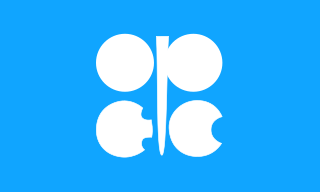
The Organization of the Petroleum Exporting Countries is an organization enabling the co-operation of leading oil-producing countries in order to collectively influence the global oil market and maximize profit. It was founded on 14 September 1960 in Baghdad by the first five members. The 12 member countries account for an estimated 30 percent of global oil production.

In October 1973, the Organization of Arab Petroleum Exporting Countries (OAPEC) announced that it was implementing a total oil embargo against the countries who had supported Israel at any point during the Fourth Arab–Israeli War, which began after Egypt and Syria launched a large-scale surprise attack in an ultimately unsuccessful attempt to recover the territories that they had lost to Israel during the Third Arab–Israeli War. In an effort that was led by Faisal of Saudi Arabia, the initial countries that OAPEC targeted were Canada, Japan, the Netherlands, the United Kingdom, and the United States. This list was later expanded to include Portugal, Rhodesia, and South Africa. In March 1974, OAPEC lifted the embargo, but the price of oil had risen by nearly 300%: from US$3 per barrel ($19/m3) to nearly US$12 per barrel ($75/m3) globally. Prices in the United States were significantly higher than the global average. After it was implemented, the embargo caused an oil crisis, or "shock", with many short- and long-term effects on the global economy as well as on global politics. The 1973 embargo later came to be referred to as the "first oil shock" vis-à-vis the "second oil shock" that was the 1979 oil crisis, brought upon by the Iranian Revolution.

Petroleum politics have been an increasingly important aspect of diplomacy since the rise of the petroleum industry in the Middle East in the early 20th century. As competition continues for a vital resource, the strategic calculations of major and minor countries alike place prominent emphasis on the pumping, refining, transport, sale and use of petroleum products.
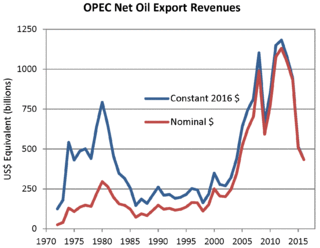
Petrodollar recycling is the international spending or investment of a country's revenues from petroleum exports ("petrodollars"). It generally refers to the phenomenon of major petroleum-exporting states, mainly the OPEC members plus Russia and Norway, earning more money from the export of crude oil than they could efficiently invest in their own economies. The resulting global interdependencies and financial flows, from oil producers back to oil consumers, can reach a scale of hundreds of billions of US dollars per year – including a wide range of transactions in a variety of currencies, some pegged to the US dollar and some not. These flows are heavily influenced by government-level decisions regarding international investment and aid, with important consequences for both global finance and petroleum politics. The phenomenon is most pronounced during periods when the price of oil is historically high.
The Iranian Oil Bourse, International Oil Bourse, Iran Petroleum ExchangeKish Exchange or Oil Bourse in Kish also known as Iran Crude Oil Exchange, is a commodity exchange, which opened its first phase on 17 February 2008.
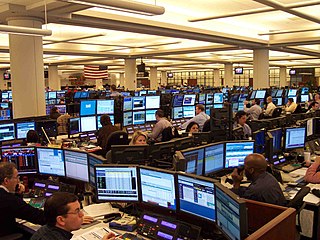
The price of oil, or the oil price, generally refers to the spot price of a barrel of benchmark crude oil—a reference price for buyers and sellers of crude oil such as West Texas Intermediate (WTI), Brent Crude, Dubai Crude, OPEC Reference Basket, Tapis crude, Bonny Light, Urals oil, Isthmus, and Western Canadian Select (WCS). Oil prices are determined by global supply and demand, rather than any country's domestic production level.
For further details see the "Energy crisis" series by Facts on File.
An energy superpower is a country that supplies large amounts of energy resources to a significant number of other countries, and therefore has the potential to influence world markets for political or economic gains. Energy superpower status might be exercised, for example, by significantly influencing the price on global markets, or by withholding supplies. Most recently, the term "energy superpower" is increasingly used to characterize nations at the forefront of energy transition and the development of renewable energy resources.
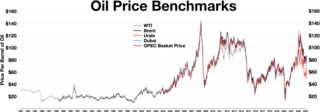
The OPEC Reference Basket (ORB), also referred to as the OPEC Basket, is a weighted average of prices for petroleum blends produced by OPEC members. It is used as an important benchmark for crude oil prices. OPEC has often attempted to keep the price of the OPEC Basket between upper and lower limits, by increasing and decreasing production. This makes the measure important for market analysts. The OPEC Basket, including a mix of light and heavy crude oil products, is heavier than both Brent crude oil, and West Texas Intermediate crude oil.

The nationalization of oil supplies refers to the process of confiscation of oil production operations and their property, generally for the purpose of obtaining more revenue from oil for the governments of oil-producing countries. This process, which should not be confused with restrictions on crude oil exports, represents a significant turning point in the development of oil policy. Nationalization eliminates private business operations—in which private international companies control oil resources within oil-producing countries—and transfers them to the ownership of the governments of those countries. Once these countries become the sole owners of these resources, they have to decide how to maximize the net present value of their known stock of oil in the ground. Several key implications can be observed as a result of oil nationalization. "On the home front, national oil companies are often torn between national expectations that they should 'carry the flag' and their own ambitions for commercial success, which might mean a degree of emancipation from the confines of a national agenda."

The 1980s oil glut was a significant surplus of crude oil caused by falling demand following the 1970s energy crisis. The world price of oil had peaked in 1980 at over US$35 per barrel ; it fell in 1986 from $27 to below $10. The glut began in the early 1980s as a result of slowed economic activity in industrial countries due to the crises of the 1970s, especially in 1973 and 1979, and the energy conservation spurred by high fuel prices. The inflation-adjusted real 2004 dollar value of oil fell from an average of $78.2 in 1981 to an average of $26.8 per barrel in 1986.
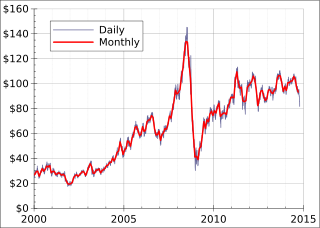
From the mid-1980s to September 2003, the inflation adjusted price of a barrel of crude oil on NYMEX was generally under $25/barrel. Then, during 2004, the price rose above $40, and then $60. A series of events led the price to exceed $60 by August 11, 2005, leading to a record-speed hike that reached $75 by the middle of 2006. Prices then dropped back to $60/barrel by the early part of 2007 before rising steeply again to $92/barrel by October 2007, and $99.29/barrel for December futures in New York on November 21, 2007. Throughout the first half of 2008, oil regularly reached record high prices. Prices on June 27, 2008, touched $141.71/barrel, for August delivery in the New York Mercantile Exchange, amid Libya's threat to cut output, and OPEC's president predicted prices may reach $170 by the Northern summer. The highest recorded price per barrel maximum of $147.02 was reached on July 11, 2008. After falling below $100 in the late summer of 2008, prices rose again in late September. On September 22, oil rose over $25 to $130 before settling again to $120.92, marking a record one-day gain of $16.37. Electronic crude oil trading was temporarily halted by NYMEX when the daily price rise limit of $10 was reached, but the limit was reset seconds later and trading resumed. By October 16, prices had fallen again to below $70, and on November 6 oil closed below $60. Then in 2009, prices went slightly higher, although not to the extent of the 2005–2007 crisis, exceeding $100 in 2011 and most of 2012. Since late 2013 the oil price has fallen below the $100 mark, plummeting below the $50 mark one year later.
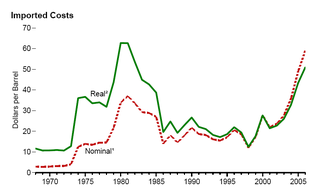
The 1970s energy crisis occurred when the Western world, particularly the United States, Canada, Western Europe, Australia, and New Zealand, faced substantial petroleum shortages as well as elevated prices. The two worst crises of this period were the 1973 oil crisis and the 1979 energy crisis, when, respectively, the Yom Kippur War and the Iranian Revolution triggered interruptions in Middle Eastern oil exports.

The 2010s oil glut was a significant surplus of crude oil that started in 2014–2015 and accelerated in 2016, with multiple causes. They include general oversupply as unconventional US and Canadian tight oil production reached critical volumes, geopolitical rivalries among oil-producing nations, falling demand across commodities markets due to the deceleration of the Chinese economy, and possible restraint of long-term demand as environmental policy promotes fuel efficiency and steers an increasing share of energy consumption away from fossil fuels.
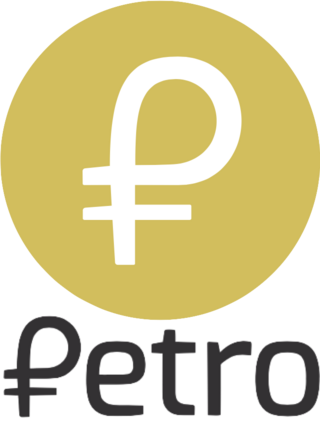
The petro (₽), or petromoneda, launched in February 2018, is a crypto token issued by the government of Venezuela.
The posted price of oil was the price at which oil companies offered to purchase oil from oil-producing governments. This price was set by the oil companies and used to calculate the share of oil revenues that oil-producing countries would receive. Between 1957 and 1972, the posted price was greater than the market price of crude oil. Between 1961 and 1970 the market price hovered between $1.30 and $1.50 per barrel, while the posted price was a constant $1.80.
Petroyuan is a form of the official Chinese currency, the yuan intended at least initially for oil trading. On 26 March 2018, the Chinese government issued the first long term oil trading contracts denominated in petroyuans. This project exists to attempt to compete with the U.S. petrodollar as a main currency in crude oil transactions, whose hegemony has led the market since the dollar standard was first established in 1971, replacing the gold standard and giving the United States the power to manage most of the world's currency supply.

On 8 March 2020, Saudi Arabia initiated a price war on oil with Russia, which facilitated a 65% quarterly fall in the price of oil. The price war was triggered by a break-up in dialogue between the Organization of the Petroleum Exporting Countries (OPEC) and Russia over proposed oil-production cuts in the midst of the COVID-19 pandemic. Russia walked out of the agreement, leading to the fall of the OPEC+ alliance.
{{cite web}}: CS1 maint: unfit URL (link)